You haven’t really safaried until you’ve trekked through Big Five country on foot. Africa on Foot Wilderness Trails in the Greater Kruger will not only get your heart-rate up, but will have the adrenaline flowing too. Richard Brown laced up his boots for an adventure of a lifetime
‘This must be one massive male leopard,’ our guide Luan Oosthuizen whistled admiringly. ‘It’s nearly as big as the lion tracks we saw earlier this morning,’ he remarked. ‘And pretty fresh, too. Even with this breeze, you can see how tightly compacted the sand still is on these central pad lobes,’ he said, pointing at the middle part of what only loosely resembled an animal spoor to the rest of us, and which God only knows how he spotted, let alone identified. We nodded blankly.
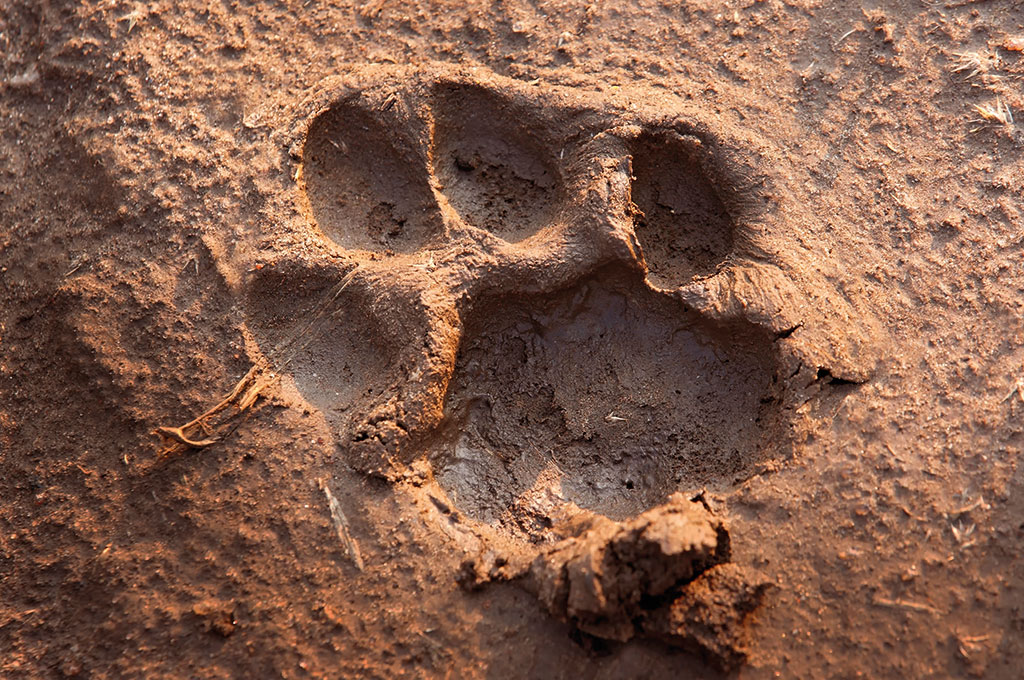
Leopard track. Image credit: Richard Brown.
I can identify an animal or two by their tracks – a skill learnt in bush school many years ago – but when it’s a hotchpotch of varied prints as on the well-trodden game trails we followed, I don’t stand a ghost of a chance. Fortunately, we had a master of the craft leading our little expedition through the wilds of the Greater Kruger.
A relative of Africa on Foot lodge in the Klaserie, this walking expedition meanders through neighbouring Maseke Balule Game Reserve, which is also part of the fenceless Greater Kruger. Slackpacking is the order of the day, and anything heavier than your water and sunscreen is transported from camp to camp by vehicle. The two guides who lead the walk carry extra water, a first-aid kit, snacks and, somewhat reassuringly, a large-calibre rifle each.
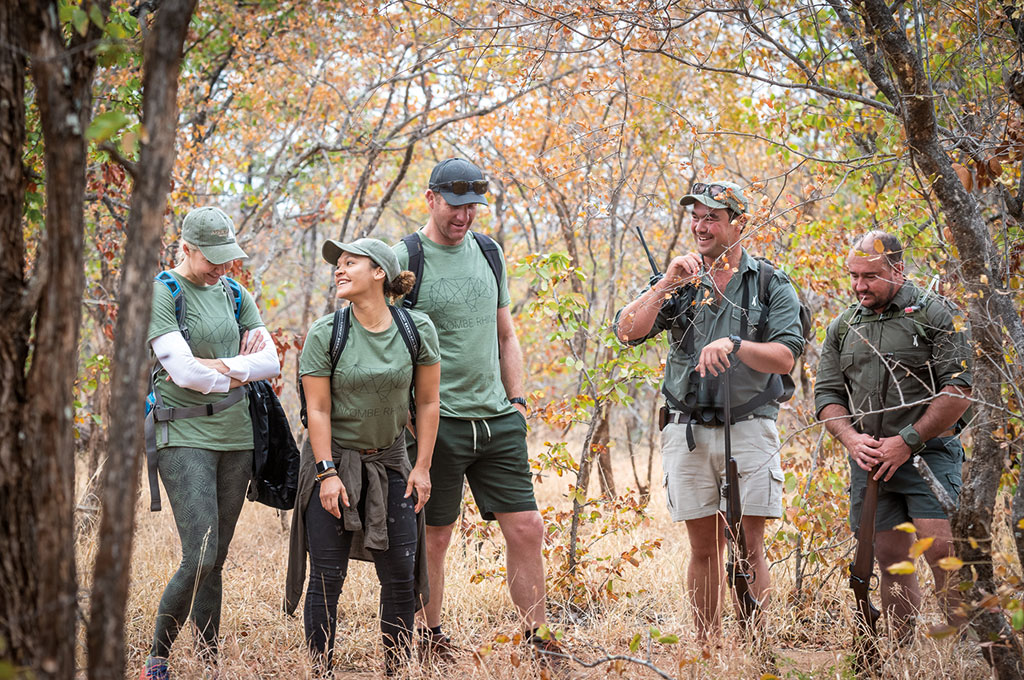
The two guides who lead the walk carry extra water, a first-aid kit, snacks and, somewhat reassuringly, a large-calibre rifle each. Image credit: Em Gatland.
The camps are fairly simple: Four dome tents with beds and ‘en-suite bathrooms’ (access to a chemical toilet and bucket shower) are positioned at one end, while the mess tent where the cook prepares delectable meals each night is at the other.
The first camp is pitched near a large watering hole that is frequented by all sorts of game, and happens to be a choice bathing spot for elephants.
After a delicious spread was concocted and devoured, we pulled up chairs around a roaring fire to get to know one another. As is custom around a campfire, past safari experiences were recounted, tentatively at first, but as the whisky flowed, the raconteurs gained confidence and the tales only grew taller with each dram. Later, one by one, glowing faces floated off to tents and fell asleep to the calls of jackal and the lonely bark of a leopard.
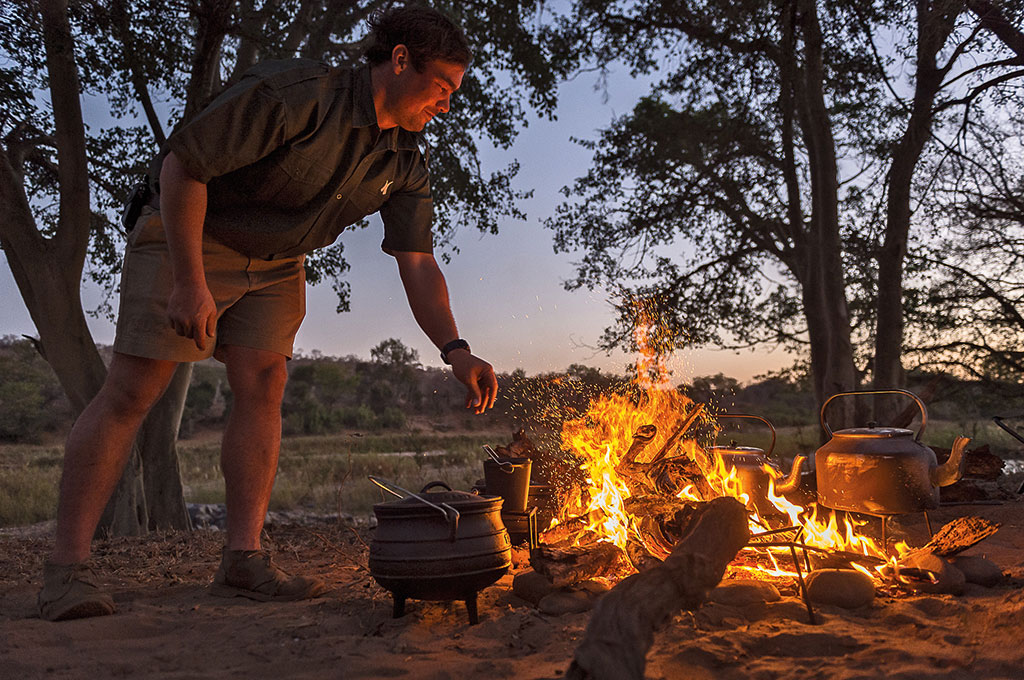
Just before dawn, we had a quick coffee and a splash of hot water to the face, and set off into the bush in single file and as noiselessly as possible. We had been trekking for a short while when we happened upon huge lion tracks, and then the leopard print mentioned earlier. The big cat spoors suddenly made us intensely aware that we were in Big-Five territory – on foot – and likely had an unseen audience following our progress. It was with this thought rolling around the back of my mind when, the next moment, my heart nearly exited via my throat.
Something erupted from a shrub to my right, an explosion of wings and squawks. Those walking ahead of me wheeled around, while I let out an uninterrupted stream of expletives, my legs suddenly the consistency of custard.
‘Just a francolin,’ Luan laughed. ‘They’re also called “heart-attack birds”.’
‘I can’t possibly imagine why,’ I said, trying to get my heart back to a human rate. On we walked.
People meditate in different ways. Some people do breathing exercises, some do yoga, and others pray. For me, a walk in the bush is as meditative as it gets. It’s you, your breathing, the light crunch of your boots on veld grass, occasional birdsong, clean air, and the acute and heightened awareness one attains when vulnerable to the elements – and by elements I mean predators. Plus, a walk in the bush is highly educational when it’s led by someone as knowledgeable as Luan.
We would stop every so often to inspect a spoor, droppings, a tree, an insect or bird, where Luan would describe and explain each with great enthusiasm and eloquence. He would tell us how to identify and distinguish between the back and front tracks of any given animal, why the rhino marked a specific spot in a specific way, exactly how an aardvark would go about digging
a hole in an anthill deep enough to later house an entire wild dog litter, and much besides. In short, a good guide such as Luan brings the bush to life for the untrained eye.
‘We call this one the “Joburg bird”,’ he said, pointing at a blue waxbill perched on a branch. ‘Look, that’s its nest in that buffalo thorn over there, and I’ll guarantee there’s a wasp near the entrance of the nest. So, “Joburg” because the property is barb-wired and he’s got a guard stationed outside.’ I had a closer look and, sure enough, there the wasp nest was, just inches from the waxbill’s.
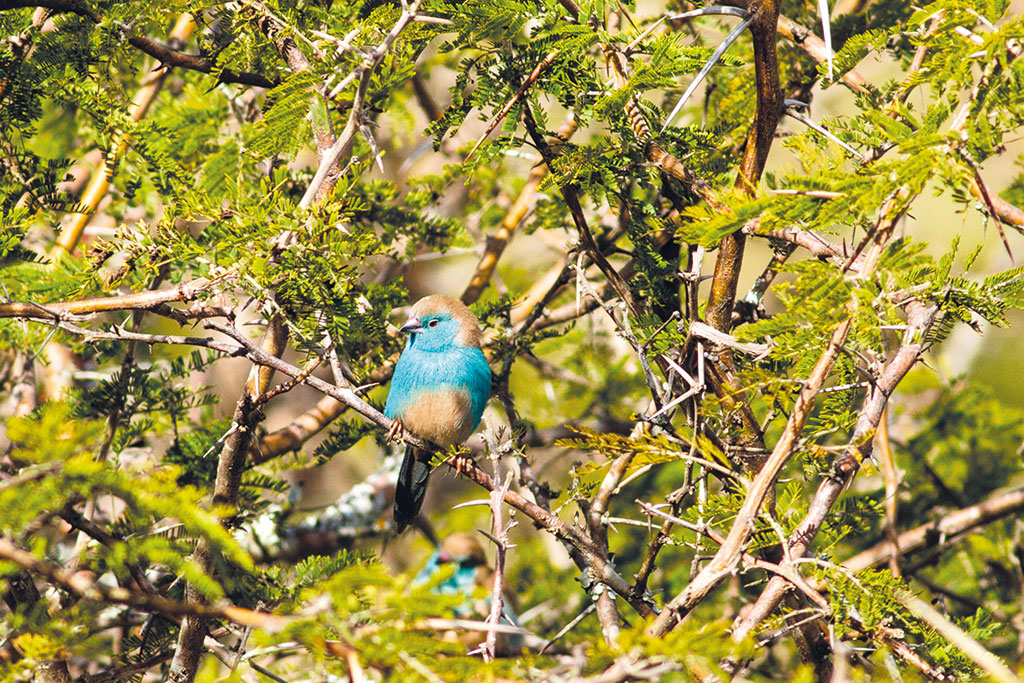
Blue waxbill. Image credit: Richard Brown
After a steep last stretch, we had a simple but delicious lunch high on a koppie overlooking a small waterhole, relaxed for a while taking in the view, and then slung on our packs and hit the trail once more.
We had been trudging through a dense mopane thicket for a while when we suddenly entered a clearing. Thirty-odd metres from us, a massive bull elephant was patently ticked off at a jackal yapping at his heels. He was upwind and hadn’t smelt us, but when he finally spotted us, he turned and came thundering our way, ears aflap. My heart had made its way up to my throat again…
I’ve seen countless elephants in my life. But it had always been from the relative safety of a game vehicle, or from a distance. Coming face to face with an agitated elephant while on foot must be the most humbling experience I can remember having. It towered larger than life. Calm as ever, Luan whistled softly and the big pachyderm stopped, seemingly unsure. Another gentle whistle, and the colossus, with an unimpressed shake of the head, made off in another direction and disappeared in seconds, only the crashing of mopanes betraying its direction. I exhaled.
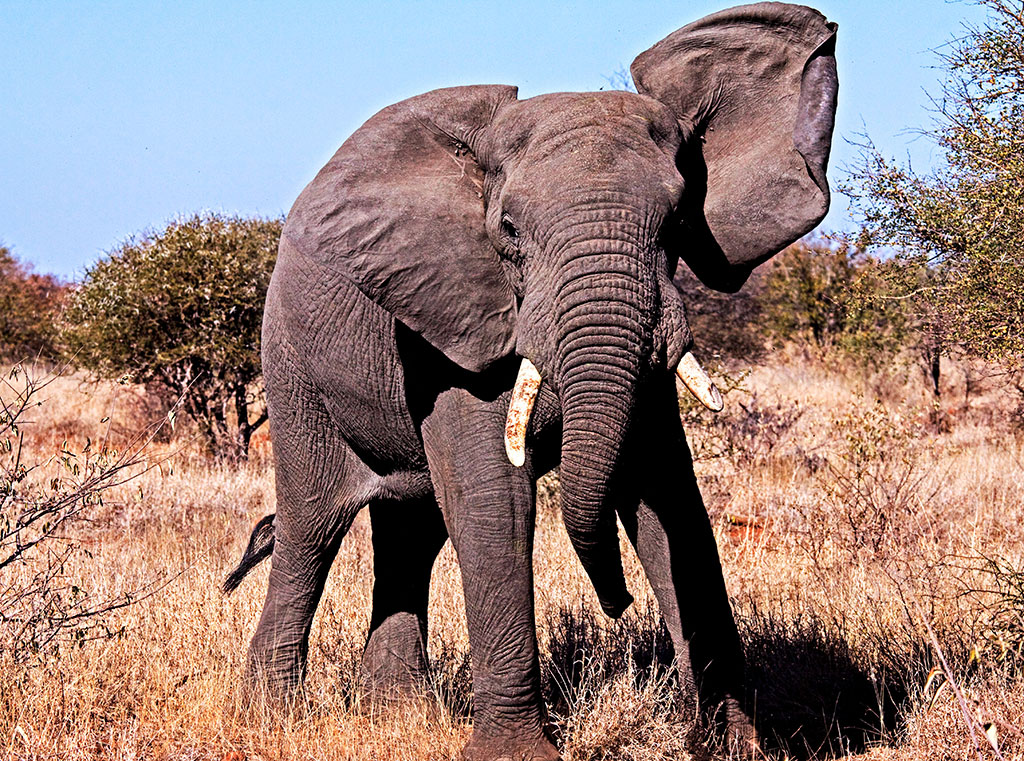
Elephant in Kruger. Image credit: Richard Brown.
In the afternoon, we arrived dusty and tired at our second camp (pitched in a dry riverbed). Legs were rested for a short while and then it was off on an afternoon game drive, which served up more elephant sightings, the biggest warthog I’ve ever seen and, unusually, a civet, all rounded off with G&Ts and easy conversation at the perfect sundowner spot.
On the last day of our bush-walk, we came across what we’d all been hoping for and dreading at the same time: lions. Again Luan’s bush-tuned eyes spotted the swish of a tail long before any of us, and cautioned us to stand perfectly still. Gradually, my eyes started to discern a number of tawny outlines. A young adult female and five adolescent males had been enjoying an afternoon snooze and were just starting their grooming ritual before the evening’s hunt. Heart … throat.
After a good look, we backed away slowly and gave them the widest of berths, arriving at the last camp elated, exhausted and, importantly, in one piece.
‘Have you ever had to use your rifle on these walks?’ I asked the question on everyone’s lips. ‘Never. Animals are more wary of us than us of them. Predators included.’
The last campsite is set on the banks of the gushing Olifants River, and what a spot it is. As we cracked open a few beers to toast a successful trek through the wilderness, I caught sight of a big croc emerging from the water on the far bank.
This is a truly wild place, I thought, and we can count ourselves lucky that such places still exist.
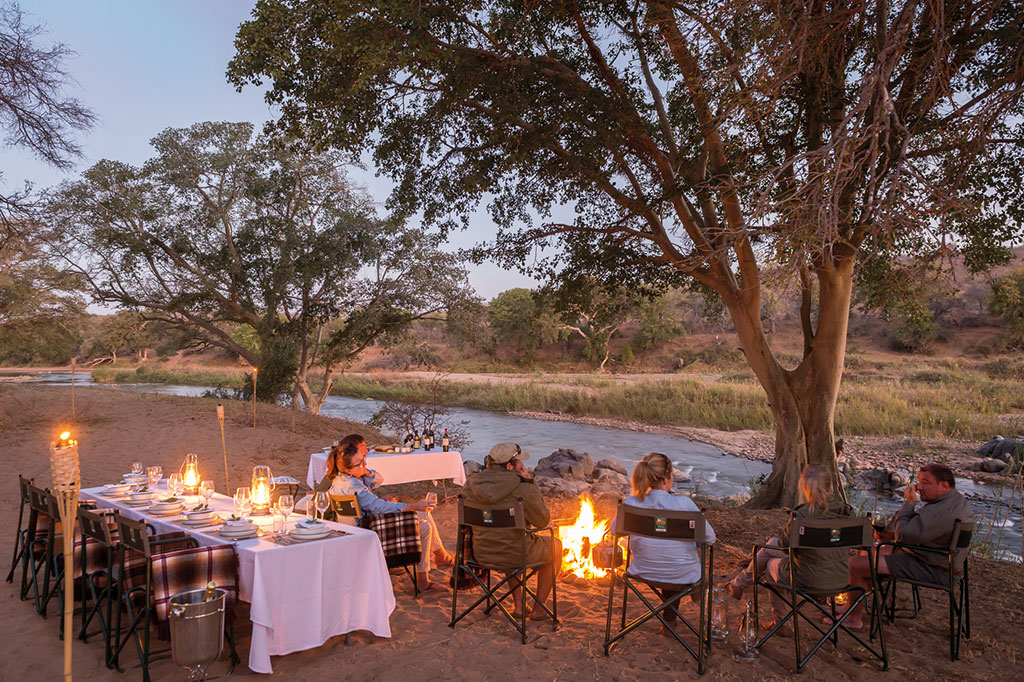
Image credit: Em Gatland
Know this
- Africa on Foot Wilderness Trails is located in the Maseke Balule Game Reserve in the Greater Kruger, in the Limpopo Province.
- You walk for 10–14 km per day for a total of around 36 km.
- Guests taking a road transfer from the airport will need to be dropped off at the Three Bridges Restaurant, where a representative will come and collect you.
- There are two airports that offer direct flights from Cape Town and Joburg: Hoedspruit (Eastgate) and Phalaborwa.
- Self-drivers will also need to drive to the Three Bridges Restaurant, where they will leave their car.
- The months between May and October offer the best walking and camping conditions, with night-time temperatures sinking to about 12 degrees in June/July and daytime rising to a mild 23.
Contact: [email protected], 021 712 5284, wilderness-trails.co.za
Text: Richard Brown
Image: Richard Brown and Em Gatland
You may also like
Related Posts
Whether you’re in a two-person hiking tent eye-balling the peaks or a full caravan in...
read more
A new guided hike in the Western Cape known as the 16 Mile Beach Challenge...
read more
Adventure seekers often look to push try new experiences which take them to the edge...
read more